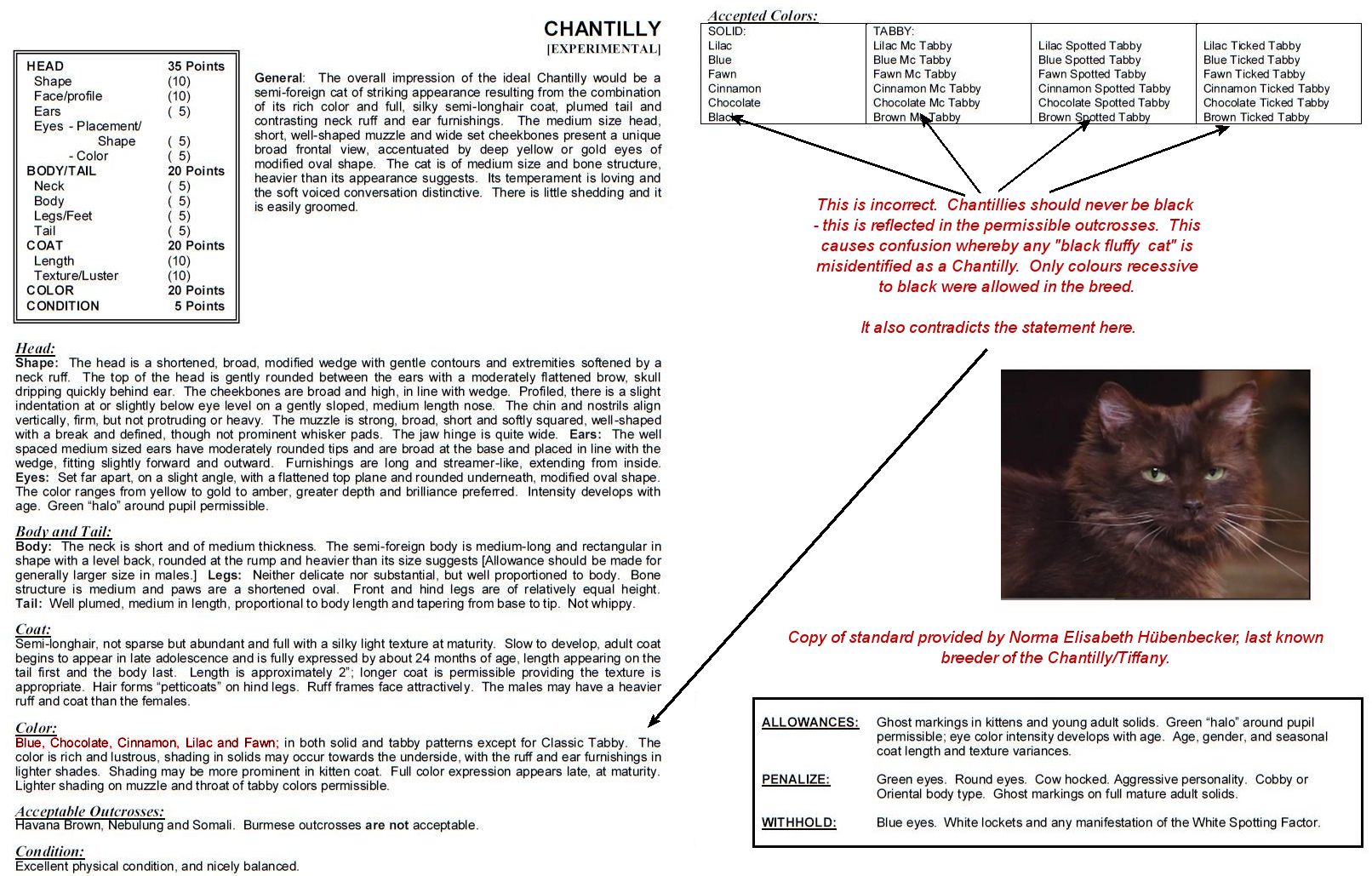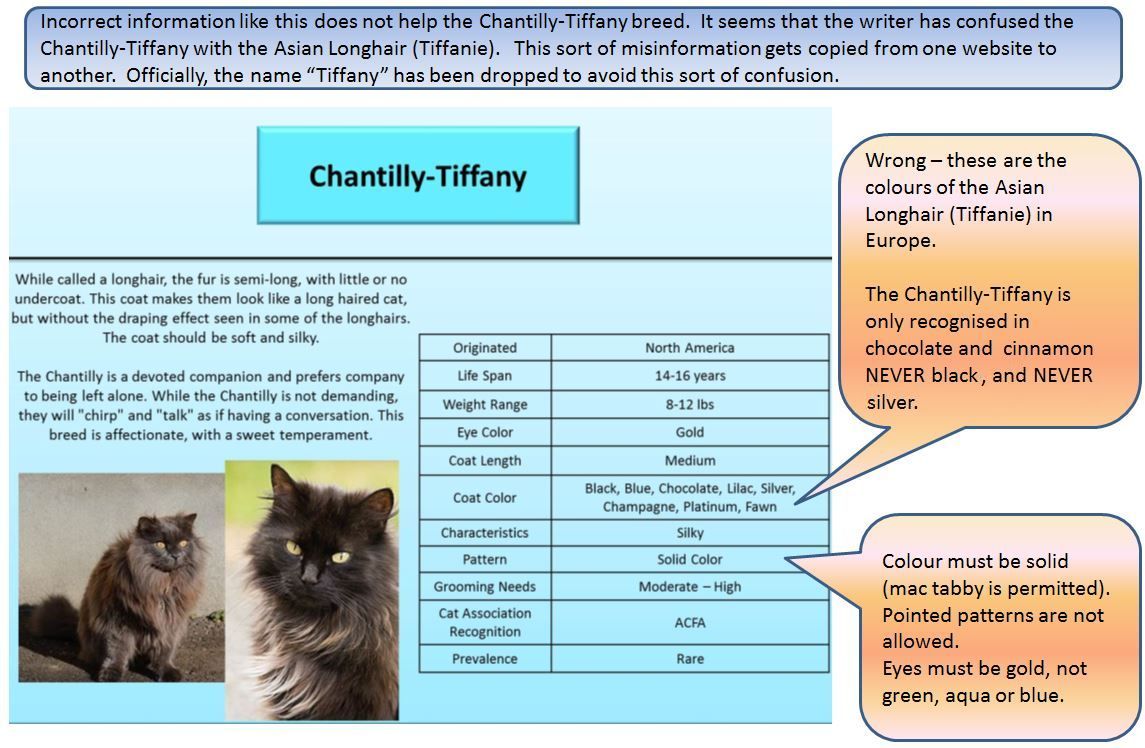
THE TIFFANY/CHANTILLY
The American-bred Chantilly/Tiffany is a medium-sized cat with semi-foreign conformation - neither cobby, nor skinny, but medium in all respects. Females are 6-8 pounds, while males are 8-10 pounds. It combines a rich, lustrous colour with a full, silky, semi-long coat, a plumed tail, a neck ruff and ear streamers. Only the eumelanin-based colours are allowed; chocolate is the best known, but blue, cinnamon, lilac, and fawn also occur. These colours may be solid, spotted or mackerel tabby patterned. Regardless of colour/pattern, white spotting and colour-pointing are not permitted. There must be no sign of darker points (as displayed by the Burmese), but there may be shading towards the underbelly (in solid colours) while the ruff and ear furnishings may appear lighter in colour.
Facially, it has a medium-sized head with a gently sloped nose, a short, broad muzzle that is softly squared with gentle contours and a break (change of angle on the nose). It has broad, high cheekbones. It should have expressive golden or amber eyes, which are a modified oval shape. The medium-sized ears are broad at the base with rounded tips tilting forward and outward. It is not extreme in any feature.
UNRAVELLING THE TIFFANY, TIFFANIE AND TIFFANY/CHANTILLY
Let's get one thing straight - the Tiffany/Chantilly is not a Longhaired Burmese. It isn t related to the Burmese and it has never been bred to the Burmese. The misconception arose because the early cats were solid chocolate and one of the breeders also bred Burmese cats so the cat-loving public assumed these longhaired cats were longhaired versions of her Burmese. And for a while they were even advertised under that name because they were so rare that no-one knew what a Tiffany (now called a Chantilly/Tiffany) was. They became so rare that existing Tiffany/Chantilly lines had to be outcrossed to Nebelungs, Havana Browns and Somalis . . . but definitely not to Balinese, Oriental Longhairs or Asian Longhairs.
The American Tiffany (Tiffany/Chantilly) is also not related to the British Tiffanie or Australian Tiffanie. It was developed (twice!) in North America between 1967 and 1987 from non-pedigree cats and while it resembles a semi-longhaired Burmese in both type and name, it is not related to that breed. Burmese kittens are born with lighter coats and dark paw pads, but Tiffany/Chantilly kittens are born dark with pink paw pads. All Tiffany/Chantilly cats in the USA must not have any Burmese blood.
In Britain, the Asian Longhair (Tiffanie, Longhair Burmese) was recognised in 1986 and was a side-effect of the Burmilla (Burmese x Chinchilla Persian) breeding programme which brought together the longhair gene and Burmese colours. It was initially called the Tiffany, but became the Tiffanie to avoid a name clash with the American breed and is now known as the Asian Longhair. In Australia, the Australian Tiffanie came from the Australian Burmilla breeding programme and is a cobbier cat with a greater amount of Chinchilla Persian blood than the European Tiffanie/Asian Longhair.

THE TIFFANY/CHANTILLY
WAVE 1: THE NEW YORK CATS
In 1967, Jennie Robinson of New York (Neotype Cattery) bought two golden-eyed semi-foreign longhaired chocolate cats from a pet shop in White Plains, New York. They had been part of an estate sale (it's amazing these days to think of cats disposed of in this way). "Thomas" was 12 - 18 months old, while "Shirley" was around 6 months old. While they probably came from the same parents, they were not litter-mates and they weren't neutered. Their ancestry wasn't known, but based on their looks early breeders thought they might be longhaired Burmese. In May 1969, the pair produced 6 semi-longhaired chocolate-coloured kittens. The kittens were solid coloured without darker points and they had pinkish paw pads. Burmese kittens would have had discernibly darker points and coloured paw pads.
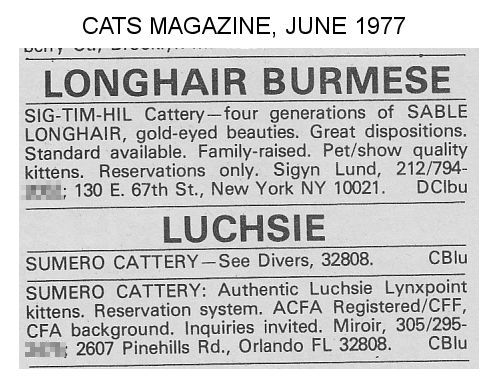
Robinson began a breeding program for these cats, and in the early 1970s the American Cat Association registered Thomas, Shirley, and their offspring as "Sable Foreign-Longhairs." The produced their first litter in 1969 and went on to produce around 60 kittens over 7 years. During the early 1970s, Robinson showed Thomas and several of his kittens in the New York metropolitan area. Other breeders who owned Thomas offspring showed the cats in Long Island and Connecticut. Robinson stated that there was no outcrossing of her cats.
Early on, the terms 'sable' (the Burmese equivalent of black, as modified by the Burmese colourpointing gene) and 'chocolate' (a solid colour recessive to black) were used interchangeably because the genetic difference was not understood at that time.
Robinson stopped breeding Tiffanys, but during the 1970s Florida-based Burmese breeder Sigyn Lund bought Robinson's remaining cats and continued breeding them until the mid-1980s. Since the cats' origins hadn't been publicised, people assumed they came from Lund's own Burmese cats and Lund named the breed-name "Tiffany" to reflect their elegance and class. Judges had felt that "Foreign-Longhair" was too general (and too suggestive of Siamese conformation) and suggested the name "Mahogany." Because the breed was so rare, the ACA had already dropped it from recognition. None were ever registered as Tiffany and the previous "Foreign Longhair" registrations were automatically unregistered. Effectively lacking a breed name, the cats were advertised as "Longhaired Burmese."
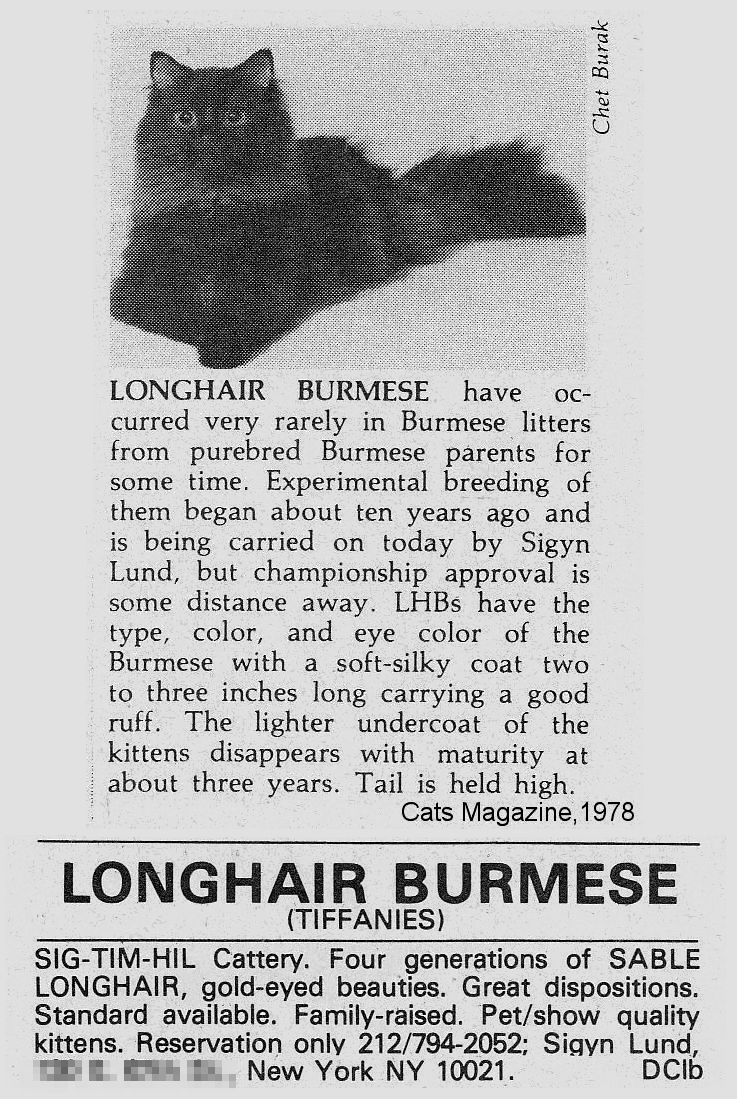
In 1979, TICA recognised the Tiffany in the Burmese section, then rescinded recognition in 1992 after finding out it was not related to the Burmese, then reinstated recognition of the Tiffany as a new breed in February 1994.
Lund guessed that the breed had its roots in the European Burmese, but never crossed any of the cats to her own Burmese. Lund provided verbal information to a researcher for "Harper's Illustrated Handbook of Cats" and the resulting article suggested the cats were Burmese longhairs derived from crosses between Burmese and Himalayans in Britain. In fact there were no such crosses in Britain! The crosses that had been done were attempts to recreate the old-style Angora cat using Foreign Longhairs, Havana (Chestnut Orientals - quite different to the American Havana Brown) and Abyssinian cats. It has been suggested that the American Tiffany/Chantilly derived from that breeding programme, but to my mind, the dates don t match up.
When Lund stopped breeding Tiffanys in the mid-1980s the breed came close to extinction. Tracy Oraas became involved in 1988 when she responded to a classified advertisement for "chocolate kittens" - echoing the story of Thomas and Shirley. The kittens had a delightful temperament and were a mystery - what breed were they? She contacted Jan DeRegt and, finding there was nothing like her cats on the showbench, began to re-establish the breed. Oraas (Opportune Cattery and later the breed club president) and DeRegt (Milgrove Cattery) contacted Robinson and Lund and ascertained that cats were unrelated to the Burmese. It was their research that suggested a link to the British Angora breeding programme.
Perhaps Thomas and Shirley actually came from the earlier British Havana breeding programme. The Havana was developed as the Chestnut Brown Foreign in Britain in 1953, recognised in 1958 and named "Havana" in 1970. The first Havanas were bred by accident in Reading, Berkshire. From there it was developed from Chocolate-pointed Siamese, Russian Blues and black "alley" cats (that may have carried longhair). In 1956 the first pair of Havana cats were exported to the USA to establish the breed there (the American Havana was then bred for a different look).
The aforementioned British Angora began in the late 1960's and early 1970's, Kernow Gerza and Kernow Koptos, brother and sister offspring of Tranby Red Tutankhamen (Sorrel Abyssinian male) and Annelida Fair Maid (Seal Point Siamese female). Kernow Gerza was a brown agouti (chocolate ticked) male, and Kernow Koptos was a black agouti female. They were intermediate in type between Siamese and Abyssinian. They also carried the longhair gene which they passed on to several of their offspring, resulting in a "longhaired Havana" Southview Trappist (sometimes mis-spelled "Trapper" and known as "Cuckoo" because he didn't resemble his parents) in 1973. This eventually led to the British Angora cat. It seems unlikely that Thomas and Shirley (born 1965/6/7) came from those cats. (For those interested, Kernow Gerza, Kernow Koptos and Trappist appear on this chart Gerza, Koptos & Trappist originally drawn to trace recessive white in Siamese.)
Another thought is that they were early chocolate Persians because the timeline and type better matches that breeding programme. The original cats may have come from early English and Dutch chocolate Persian lines. The early chocolate and lilac Persians looked much more like modern British Longhairs.
WAVE 2: THE CANADIAN CATS
Meanwhile in Canada, a farm owner also had a Tiffany-type cat. In 1973, a pregnant long-haired semi-foreign chocolate, gold-eyed cat of unknown ancestry appeared at his home and produced kittens that were perfect replicas of their mother. Offspring of these cats were acquired by Canadian breeders interested in helping Robinson and Lund re-establish/reinvigorate the lost American Tiffany. Permissible outcrosses were European-type Angoras (Foreign Longhairs/Mandarins), Havana Browns, Nebelungs and Somalis. This introduced new colours and patterns into the breed. The Tiffany re-emerged in the late 1980s in a wider range of colours.
In 1992, Canadian breeders had to rename their cats because of an earlier British breed called the Tiffanie (Burmilla Longhair). The name "Foreign Longhair" now belonged to semi-longhaired Oriental cats so the revived breed became "Chantilly/Tiffany," retaining its original name (which pre-dated the Burmilla Longhair) as part of its name. These days, it is known in its home country as "Tiffany" or "Chantilly" or "Tiffany/Chantilly" and the British cats are more often known as "Asian Longhairs." "Chantilly" retains the connotation of elegance and refinement.
Outcrossing meant that the cat also occurred in cinnamon, fawn, blue or lilac, both in solid colours and mackerel or spotted tabby, though chocolate was the preferred colour. ACFA accepted the Chantilly in the wider range of colours, but did not permit classic tabby. The standard called for yellow eyes that could range to gold or amber and have a green halo around the pupil. They were eligible for championship status in UFO, and as "New Breed or Colour" in CCA and AACA and were registered as New Breed or Colour with TICA.
WAVE 3: THE AMORINO CATS
The last known Chantilly breeder in the USA was Amorino Cattery (founded 2001) in Illinois, but a devastating fire destroyed the archives and cattery. Hershey Nugget, a chocolate tabby Chantilly was the sire of all of their first generation kittens. Following Nugget was Lilas Nuage (French for lilac cloud), a beautiful lavender female and then a solid blue female Chantilly, Cadeautje ( Dutch for little blue present ) known as "Katie".
Nuage did not conceive easily and died during birthing her last litter; both kittens also died. Katie was born with a heart murmur and died of a heart attack after producing several litters. In 2012, the cattery was destroyed by fire and although Nugget was one of the cats rescued, he had such severe lung damage that he had to be put to sleep. In 2014, Nugget' and Nuage's son Amorino El Tigre Del Cioccolato ("Chocolate Tiger") aka "Boo" died due to insulin dependent diabetes.
Amorino Cattery describe the Chantilly as a mix of 4 foundation breeds: Havana Brown (for the deep chocolate colour), Somali (for the plumed tail, ruff and britches), Abyssinian (the parent of the Somali breed) and Nebelung (for the length and texture of the coat and the set and shape of the ears). In 2014, the Chantilly was so rare that there was an appeal for help to breeders of these 4 foundation breeds. The other Chantilly catteries were Cacao Criadero Cattery (Norma Hubenbecker, Skien, Norway - the cattery name means "chocolate nursery") and LePors Cattery (Anne-Marie Brown, Nova Scotia), but these also had few cats and without suitable outcrosses, their Chantilly breeding programmes ended.
Captivated by the Chantilly, Norma Elisabeth Hubenbecker searched her native Norway, Europe, and even Australian to find one. Finally she found 4 year old Frosty from the Amorino Cattery, Carterville, Illinois, the home of breeder Annie Davenport-Parini. As an adult, Frosty was laid-back, but younger Chantillies have far more energy due to the combination of Havana Brown, Nebelung and Somali in their ancestry.
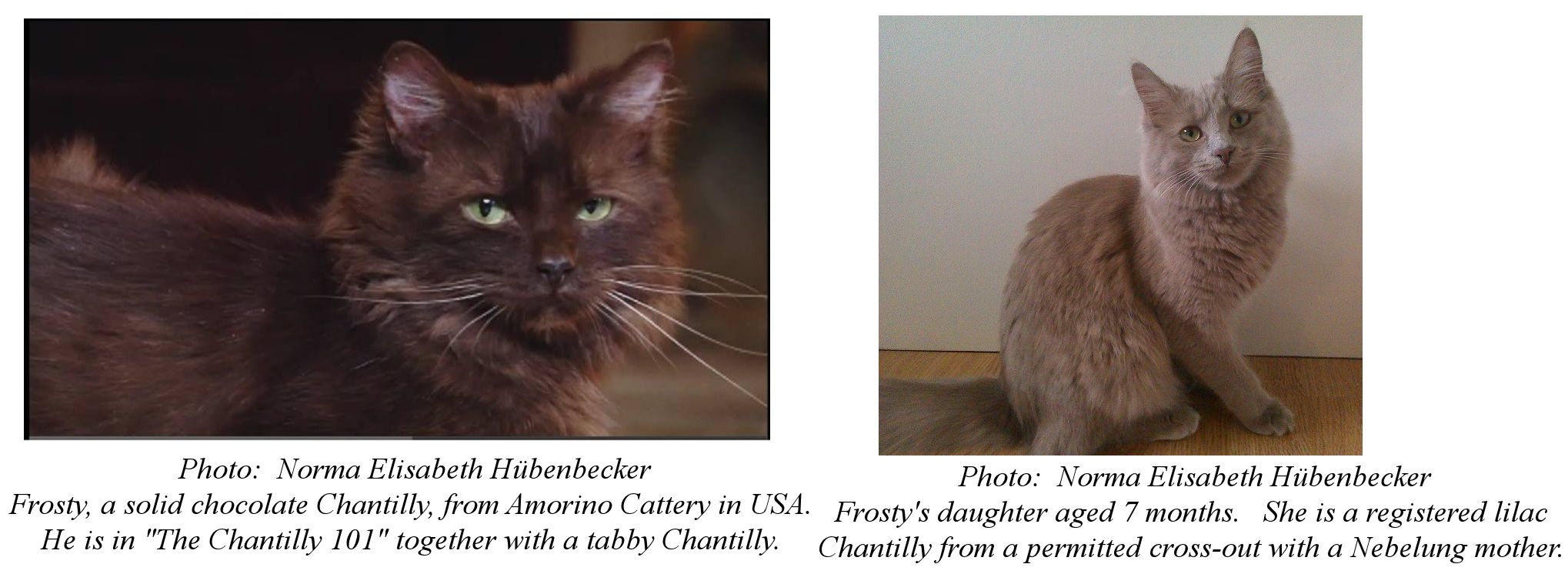
Above are the last known Chantilly cats, both belonging to Norma Elisabeth Hubenbecker. Frosty was a solid chocolate Chantilly from Amorino Cattery. He appears in "The Chantilly 101" together with a tabby Chantilly. It was filmed at his breeder's house before Norma bought him. Due to cancer he was put to sleep in 2015. At the time of writing (October 2017) Norma still had his daughter, a registered lilac Chantilly from Nebelung outcross mother. Due to the fact that there were no cats tobreed her to, she was spayed. This means there are no intact Chantilly cats anywhere and no Chantilly breeders. The idea of Chantilly cats, or Chantilly mixes, being in shelters is fallacious.
A lot of fluffy black moggies are misidentified as Chantilly, but this colour (which is dominant to chocolate and cinnamon) was never present in the breed. Colourpoints identified as Chantillies are equally fallacious (see "Fake Chantilly Cats" below and are closer to the Tibetan breed (mink variant Balinese/longhair Tonkinese). All original bloodlines are lost, but in terms of phenotype it could be recreated using the 4 foundation breeds mentioned earlier, or using solid chocolate Tiffanie cats (Asian Longhairs) from Europe.
FAKE CHANTILLY CATS
The Chantilly is a semi-foreign, semi-longhair with golden eyes, bred in solid, mac tabby and spotted chocolate, cinnamon, blue, lilac and fawn - no darker points, no mask, no white and no red-based colours. It has a pedigree and can be registered in a number of cat associations (note that it isn t universally recognised). The only permitted Chantilly outcrosses are Nebelung, Havana Brown and Somali. This has not stopped unscrupulous breeders from using the name for completely unrelated, unregistered cats.
A Canadian breeder operating under the name "King of Siam," and from three locations (Calgary (Alberta), Toronto (Ontario) and one in British Columbia) misused the Chantilly name to sell blue-eyed masked cats bred from Balinese cats. Chantillies are never masked and never blue eyed. In 2013 Annie Davenport-Parini (Amorino Cattery) investigated American and Canadian registries to stop the fake Chantilly programme/use of the Chantilly name and issued a buyer beware alert on social media. The breeder (possibly a bulk-breeder) didn't belong to any association. King of Siam's cats don't/didn't meet the Chantilly standard, are not registrable under the Chantilly name, and won't form part of any recognised Chantilly breeding programme.
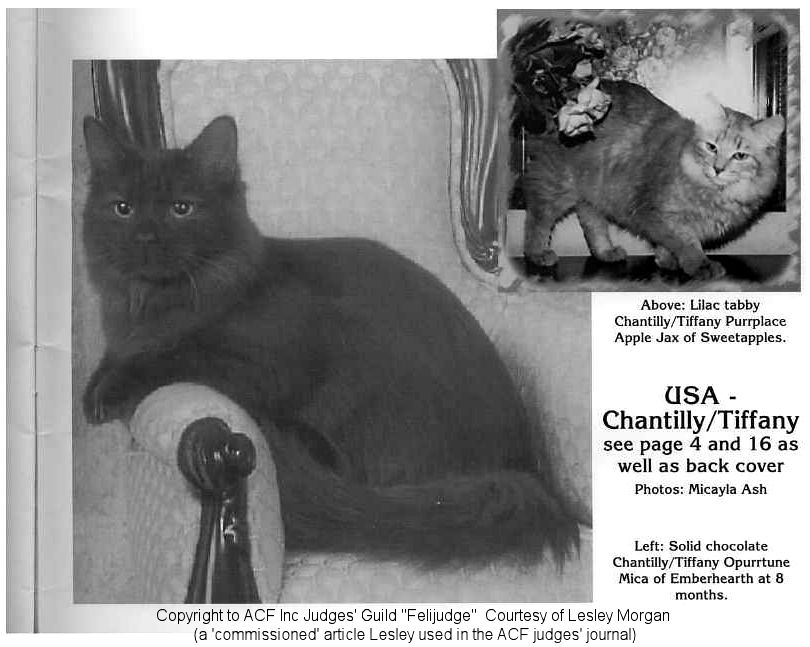
The following description is based on the 1995 Chantilly FAQ by T Oraas and Jennie Robinson. In the 1990s, breeders trying to re-establish the breed breed placed great emphasis on retention of traditional conformation and health as found in the New Yor cats bred between 1967-1987.
Physical Description
The Chantilly/Tiffany is a semi-foreign medium-sized cat. It is distinctive for its rich colour, full, silky semi-long coat, plumed tail, contrasting neck ruff and ear streamers. It has a medium-sized head with a gently sloped nose and short, broad muzzle that is softly squared with gentle contours and a break. The chin is firm. The cheekbones are broad and high. The eyes are a modified oval shape, expressive and gold-yellow-amber. The ears are broad at the base and medium sized, with rounded tips tilting forward and outward. The body is classed as "semi-foreign" (akin to the Asian breed group), medium in size and length, neither cobby nor svelte. Muscle and boning is medium. Females are 6-8 pounds, males are 8-10 pounds. The breed standard requires rich and lustrous colouration in chocolate (the original and best known colour) and cinnamon, though blue, lilac and fawn are found in the reinvigorated breed due to outcrossing. The colours occur in solid and mackerel tabby patterns. The original description was "a chocoholics delight" reflecting the preferred colour and some associations only accept the chocolate and cinnamon colours. It must not be pointed - not colourpoint, mink or Burmese-pointed. Silver is not allowed. It must not have white markings.

According to Cat Fancy in September 2014, quoting from the breed standard The overall impression of the ideal Chantilly would be a semi-foreign cat of striking appearance resulting from the combination of its rich color and full, silky semi-longhaired coat [. . .] Its temperament is loving and the soft-voiced conversation is distinctive.
Temperament
The Chantilly/Tiffany is loyal and becomes a close, affectionate companion that is not overly demanding or mischievous. They are neither as placid as Persians, nor as active as Orientals, but have a moderate activity level. They usually, bond closely to one person in the household and communicate in chirps and trills. They needcompany, either human company or the company of another pet. While they may insist on being in proximity to their chosen human, they may be conservative with strangers.
Health and Care
The Chantilly is a healthy breed with no particular problems. A few have finicky digestions and don't tolerate food with a high corn (maize) content or sudden changes of diet. Females may have prolonged labour, and are not too anxious to wean. The kittens are quite slow to accept solids. Overall, it is a minimal care breed. Although it is not classed as hypo-allergenic, its silky little-shedding coat may be tolerated by some allergy sufferers and it needs only occasional combing, especiially of the ruff and hindquarters (trousers). The coat does not mat easily. Ears seem inclined to wax build-up and should be swabbed regularly.
